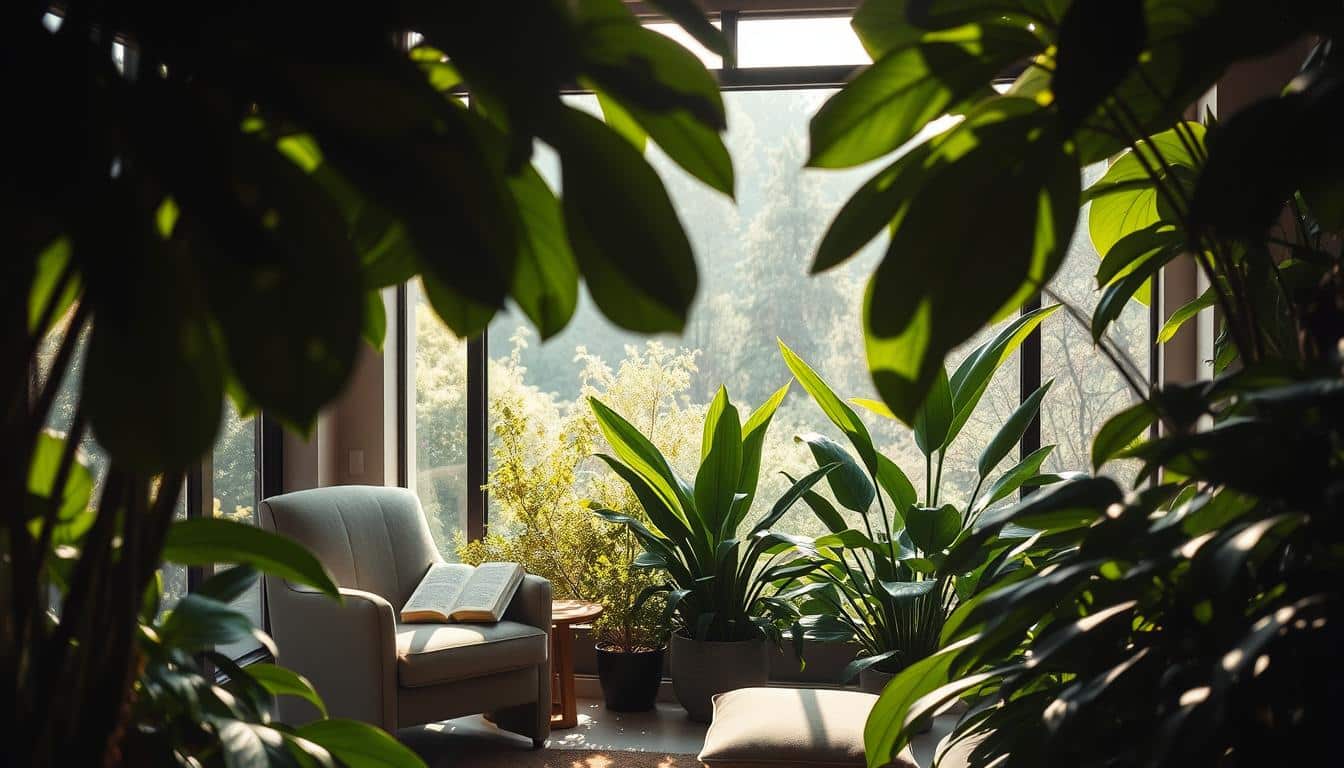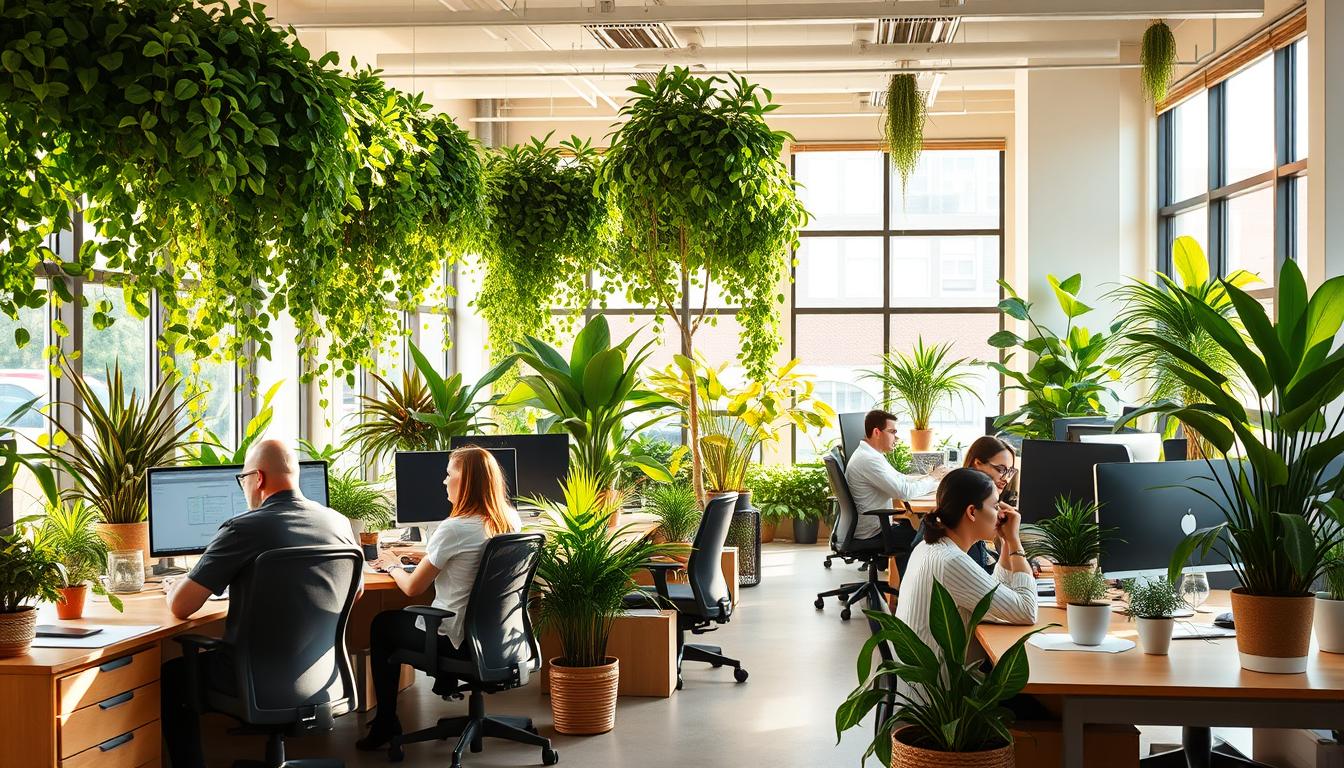Putting plants in city spaces offers great benefits for our senses. As cities get busier, adding nature becomes key to creating calming gardens. These special gardens help people feel better by fighting city stress and making life nicer.
Sensory gardens are peaceful places that welcome everyone to enjoy nature. They let us experience different sensations. By focusing on where to put greenery, we make our areas better and support our mental well-being.
The Importance of Greenery in Urban Spaces
Cities often lack green spaces, hurting our mental and physical health. Adding plants and trees to cities can make life better for everyone. These green spots bring many environmental perks.
Studies show green places can make us feel happier and less stressed. Parks and gardens are where people come together, helping communities grow stronger. They provide fun activities and encourage people to meet.
Green spaces also clean the air, which is very important in busy cities. They help cool down the streets, support wildlife, and make cities prettier. Well-planned green areas create healthier communities and bring people closer.

Understanding Sensory Relief and Its Benefits
Sensory relief is about stimulating our senses like sight, smell, touch, taste, and sound. This helps improve our emotional health, especially when stressed or feeling down. By interacting with nature, sensory gardens offer a peaceful escape that encourages mindfulness.
Studies show being around nature boosts our brain function and mood. It helps those with sensory processing issues or developmental challenges find comfort. Having plants around us can make our minds clearer and our emotions more stable. So, adding sensory gardens in places we go every day is very important.
Greenery Placement for Sensory Relief
Greenery placement is key to creating relaxing spaces. It promotes mental health. Choosing and arranging the right plants makes a big difference. A soothing atmosphere helps with emotional health.
Creating Calming Environments
Use soft colors and gentle textures in your garden. Shades of green, blue, and lavender bring peace. Velvety or fuzzy plants feel good to touch. Winding paths with plants encourage peaceful walks. This deepens our nature connection.
Enhancing Mental Well-being
Mental well-being is boosted by engaging our senses. Lavender and rosemary plants smell great and uplift our mood. Greenery lowers stress and promotes mindfulness. It helps us live in the moment. Combining sensory elements in gardens supports stress recovery.
Selecting the Right Plants for Sensory Relief
Choosing the right plants is crucial for creating sensory-rich spaces. The right plants enhance the healing qualities of a place. They use scents and textures to deepen sensory engagement.
Aromatic Plants for Relaxation
Plants like lavender, rosemary, and mint bring relaxing scents to any space. Lavender is known for its calming scent, ideal for stress relief gardens. Rosemary boosts concentration while its scent refreshes the senses. These plants’ aromas draw people in, making them want to explore more.
Textured Plants for Tactile Engagement
Tactile plants such as lamb’s ear, ferns, and succulents offer various textures to touch. Lamb’s ear has velvety leaves that are soft to touch. Ferns add a delicate, feathery look. Succulents provide a distinct structure. Touching these plants makes the sensory experience richer, helping people feel closer to nature.
Designing Multi-sensory Spaces
Designing spaces that appeal to all five senses requires careful planning. We use different plants, textures, and sounds to create special places. These gardens are more than just pretty; they make our senses come alive with variety.
Adding things like water features makes spaces peaceful to both see and hear. You may want to add:
- Textured plants that invite tactile interaction
- Aromatic plants to engage the sense of smell
- Thoughtful layouts that encourage exploration
Making sure everyone can enjoy these places is crucial. Inclusive gardens help people connect and learn through their senses. They offer more than beauty; they bring people together to share in the sensory joy.
Integrating Water Features for Auditory Calmness
Water features are key to making sensory gardens special. Their sounds are soothing and create a welcoming vibe. This is ideal for relaxation and mindfulness. Adding things like fountains and waterfalls can turn any city space into a peaceful area full of nature.
Benefits of Fountains and Waterfalls
Adding water features provides an amazing sound experience for visitors. The light sound of water touches our hearing in a special way and does a lot:
- It offers a calm sound that hides city noises, helping people forget city stress.
- It also makes the garden more interesting to look at, making people stop and think.
- This calming sound can reduce stress and make us feel better overall.
Choosing the correct water features is super important. It helps sensory gardens become peaceful spots in busy lives.
Pathways and Layouts that Enhance Sensory Experience
Pathways and garden designs are key to making sensory experiences better for visitors. They spark curiosity and encourage people to explore more. This makes a walk through the garden a rich and engaging activity.
By using different elements, pathways turn a simple walk into an adventure. This adventure is full of touch and sensory discoveries.
Choosing Textured Pathways
Textured pathways make the garden experience more sensory. They use materials like pebbles, wood, and stone. This variety adds to the feeling of the journey through the garden.
- They make you more mindful, focusing on what you feel under your feet.
- They lead visitors through the garden, showing off different designs.
- They make the garden a place of discovery, with new textures and shapes to find.
Adding sensory pathways to gardens creates a place where visitors really connect with nature. The mix of tactile paths and garden designs makes the sensory journey even better.
Community Engagement in Greenery Placement
Local residents playing a role in greenery placement can make a big difference. When they help design and care for sensory gardens, they feel like they truly belong. This promotes friendship and teamwork in the community.
Working together on gardens turns bland spaces into lively spots for meeting and learning. These activities make us more aware of nature’s importance. They also offer healing moments, helping us bond with nature and each other.
Getting different kinds of people involved in green spaces creates engaging areas for exploring our senses. These efforts connect individuals from various backgrounds. This not only strengthens community bonds but also makes for calming and joyful spots.
Maintenance Tips for Sustainable Sensory Gardens
Keeping up a sensory garden means staying dedicated to its care and making green choices. To make sure plants flourish and keep stimulating senses, regular upkeep is key. Each season requires its own care approach, focusing on trimming, hydration, and keeping the soil healthy.
To make your garden both healing and eco-friendly, follow these pointers:
- Seasonal Care: Tailor your garden work to fit the season. Use spring for new plantings and getting things fresh, while fall should be about getting ready for the cold.
- Regular Pruning: Cutting back plants not only helps them grow but also keeps the garden looking good. It stops plants from becoming too cramped and boosts airflow.
- Consistent Watering: Make a watering plan to make sure your plants always have enough to drink. Drip irrigation is a water-saving option to consider.
- Composting: Turn your organic leftovers into compost to feed your plants. This cuts down the need for chemical fertilizers and keeps your soil rich.
- Prioritize Native Plants: Using plants native to your area supports local wildlife and makes your garden more durable.
- Engage the Community: Get local people or groups involved in taking care of the garden. It builds a community spirit and makes everyone feel part of something special.
Following these steps will help keep your sensory garden a welcoming and lively space for many years. It’s a way to enrich both nature and your neighborhood.
Conclusion
Greenery in cities is more than decoration. It helps us feel better, making our lives in crowded places nicer. Sensory gardens, with their beautiful designs, touch all our senses. They let us heal and enjoy nature’s goodness. These special places make us happy and connect us to the earth.
These gardens also bring people together, creating a sense of community. As cities see their worth, we’ll find more green spaces designed for us to enjoy. This means better health and stronger connections among neighbors.
Sensory gardens show how important nature is to us. They’re not just pretty to look at. They refresh our soul and improve our well-being. With them, cities can be places of joy and peace.



